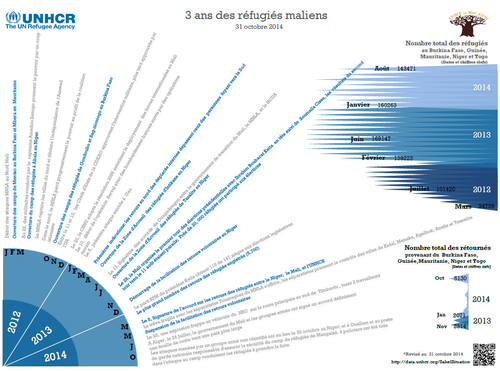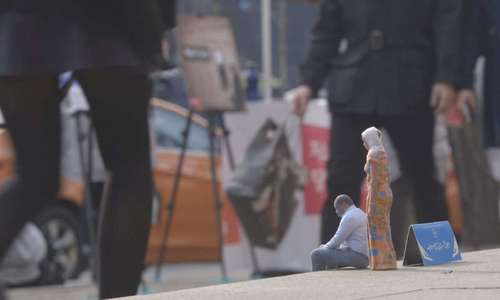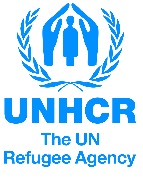« Nouveaux visages » pour le bureau de l’UNHCR

Nouveau décor pour orner la façade du bureau de l’UNHCR à Niamey. Après une fresque qui symbolisait l’accueil et la solidarité de peuple Nigérien, place aujourd’hui à une série de portraits de réfugiés maliens réalisés par Titouan Lamazou, artiste UNESCO pour la Paix, lors de son séjour au Niger en 2014 et présentés dans son ouvrage « Retour à Tombouctou » (http://www.titouanlamazou.com/en ). L'opération de l’UNHCR au Niger remercie chaleureusement Titouan pour nous laisser faire vivre ses œuvres en plein Niamey et l’invite à se rendre prochainement à Diffa pour continuer à mettre en valeur les visages et les vies.
Pour voire d’autres œuvres de Titouan Lamazou réalisées lors de son séjour au Niger : http://unhcrniger.tumblr.com/Titouan
Jhonel est un slameur nigérien. Il y a quelques années, il écrivait un slam sur les réfugiés à travers l’Afrique: « Je pars d’ici ». C’était avant que son pays en accueille à son tour. L’UNHCR Niger s’est rapproché de Jhonel, pour donner une place aux réfugiés nigérians et maliens dans son texte, et de la musicienne Laetitia Cécile afin qu’ils retravaillent ce slam en musique.
Au milieu du flot de vidéos, photos et autres articles de presse qui visent à rendre visible les problématiques des réfugiés mais qui se perdent dans la masse d’information, l’empathie est difficile. La musique est un autre levier. Nous laissons à vos oreilles le soin de vous toucher. Le 20 juin se célèbre la « Journée Mondiale des Réfugiés ».
Auteur et Voix: Jhonel
Compositeur et Piano : Laetitia Cécile
Mixage: David Octor
Source: SoundCloud / unhcrniger
Advocacy for Niger by UN High Commissioner for Refugees Antonio Guterres
UN High Commissioner for Refugees, Antonio Guterres, took the floor last week in New York and advocated for “frontline states” that have to absorb refugee influxes from neigbouring countries, such as Niger
3 years of malian refugees - key events

Près de 3 ans pour les réfugiés maliens : chronologie des principaux évènements
En janvier 2015, cela fera 3 ans que le nord du Mali est entré dans une crise de laquelle il n’est toujours pas ressorti. De l’ouverture des camps à celle des Zones d’Accueil des Réfugiés, en passant par les espoirs nés des élections présidentielles maliennes jusqu’aux récentes attaques de Ouallam et Mangaize, cliquez sur le lien suivant pour revenir sur la chronologie des principaux évènements.
English version http://data.unhcr.org/SahelSituation/download.php?id=984
Version francaise http://data.unhcr.org/SahelSituation/download.php?id=985
Situation au nord-est du Nigeria : L’UNHCR réitère ses recommandations aux pays d’asile

L’UNHCR a publié le lundi 27 octobre un document intitulé « International Protection Considerations with regard to people fleeing northeastern Nigeria (the states of Borno, Yobe and Adamawa) and surrounding region”. Ce document est la mise à jour d’instructions déjà publiées en Octobre 2013. Alors que la situation dans le nord-est du Nigeria ne cesse de se dégrader, ce document réitère les recommandations et la position officielle de l’UNHCR sur les besoins de protection internationale pour les personnes fuyant ou ayant fui le Nigeria. Ce document vient rappeler au pays d’asile leurs obligations vis-à-vis du droit international en ce qui concerne l’accès au territoire et aux procédures d’asile, la suspension du rapatriement forcé, la préservation du caractère civil de l’asile et la séparation des civils et des combattants. Cliquez sur le lien pour lire le document (en anglais) : www.refworld.org/docid/5448e0ad4.html
UNHCR Meet: Nation of the Displaced
L’UNHCR lance son application gratuite “UNHCR News App”
L’UNHCR vient de lancer son application gratuite “UNHCR News App” pour renforcer la diffusion de l’information vers les médias mais aussi vers un public large. Nouvelles, histoires de vie, communiqués de presse, photos, vidéos, documents de références, cartes, tous les supports sont proposés en 3 langues (français, anglais, arabe) pour permettre à chacun de mieux appréhender la complexité des situations d’urgence et les déplacements de populations qu’elles provoquent.
Télécharger l’application en suivant le lien suivant :
http://www.unhcr.org/pages/53a3feca6.html

| First Tripartite Commission Meeting holds in Bamako |
 | Première réunion de la commission tripartite entre le Mali, le Niger et le HCR le 12 juin à Bamako | Following the provisions of the first Tripartite Agreement on May 3, 2014 in Niamey for the voluntary repatriation of Malian refugees, the Tripartite Commission met for the first time on June 12 in Bamako. The commission which is charged with overseeing the implementation of favorable voluntary repatriation of Malian refugees adopted its internal rules and regulations and expressed its commitment to reinforce protection monitoring in northern Mali. This is in a bid to follow up on the ongoing peace and stability efforts and to ensure safety and dignity for returning refugees. When conditions would have been fully met in the future, “go and see visits” for refugees and “come and tell visits” for returnees and notables to enable the refugees take informed decisions would be facilitated. . |
 | Comme prévu par l'Accord Tripartite du 3 mai 2014 de Niamey sur le retour volontaire des réfugiés, la Commission Tripartite s'est réunie pour la première fois le 12 juin à Bamako. Cette commission qui veille à la mise en place des conditions favorables au rapatriement volontaire des réfugiés maliens, a fixé son règlement intérieur, et s'est engagée à renforcer le monitoring de protection au Nord Mali. Ceci afin de suivre les efforts de stabilisation pour assurer un retour dans la dignité et la sécurité des réfugiés. Il est notamment prévu à l'avenir, lorsque les conditions seront réunies, d'organiser des visites entre les camps au Niger et les zones de retour au Mali (go-and-see visits, come and tell visits) pour renforcer l'information des réfugiés avant de prendre leur décision |
|---|
3D exhibition in Seoul sheds light on “invisible” refugees - Malian refugees feature in campaign
This webstory is also available at : http://www.unhcr.org/52fb51389.html SEOUL, Republic of Korea, February 10 (UNHCR) – In this highly-wired country of 50 million tech-savvy people, it is almost impossible for anyone to spend a lifetime completely hidden from the public eye. |  The mini-figurines of refugees featured in the “Invisible People” exhibition struggle to be seen in the busy streets of Seoul. |
|---|
To shed light on the lives of refugees like Chakma, UNHCR, Cheil Worldwide and the Seoul Museum of Art have joined hands to hold a 3D refugee figurine exhibition in Seoul. Titled “Invisible People”, the exhibition is aimed at making refugees in and outside South Korea “visible” using advanced technology that helped create the miniature figurines.
Organized as part of Cheil Worldwide’s corporate social responsibility activities, UNHCR and the firm together met refugees in South Korea and Niger over the last two months. The refugees had their photographs taken and three-dimensional mini-figurines were produced based on their images. In-depth interviews with the refugees were also captured on video.
The results – dozens of figurines, each no larger than a handspan – are displayed in hidden places such as stairways, shelves and windowsills of the Seoul Museum of Art. Visitors who find the figurines can listen to the refugees’ stories by connecting their mobile phones with the QR/NFC codes inserted in each figurine.
To reflect the widespread indifference towards refugees, several large screens have been displayed in the main exhibition hall showing real-time video of people walking past the refugee figurines nonchalantly.
The small size of the figurines and the unusual places where they are displayed are in line with the goal of the exhibition to help visitors find refugees and “make the invisible, visible”, organizers explained.
“Instead of telling people about refugees in a straightforward message, we were hoping to help visitors think and understand the difficulties and needs of refugees while finding them and listening to their stories one by one,” said Song-ha Lee, a copywriter at Cheil Worldwide and co-director of the exhibition.
South Korea became signatory to the 1951 Refugee Convention in 1992 and recognized its first refugee in 2001. A growing number of people have been seeking asylum in the country, seeing it as the homeland of UN Secretary-General Ban Ki-moon and a country with advanced human rights.
By the end of 2013, more than 6,600 people had sought asylum in South Korea from countries such as Pakistan, Syria and Myanmar. Some 370 of them were recognized as refugees by the Korean government.
During an interview with UNHCR and Cheil Worldwide in Niger, Ouda Ag Mohamad, a refugee from Mali, wished that people in Korea and around the world would “never have to leave their homes and become refugees” like himself. “I hope you can live in dignity and security throughout your life,” he said. “I also hope peace will be restored in my country as soon as possible so that I can return home.”
Dirk Hebecker, Representative of UNHCR Korea, asked people to never forget that “refugees leave their homes and family not because they want to, but because they have to”. “I hope more people will get to know about the plight of refugees in and outside Korea, and recognize them as visible people,” he said. “We are thrilled to be part of such a great exhibition made possible by a creative, dynamic team of young advertising professionals.”
The exhibition of 3D refugee figurines opened on February 7 and will run through March 2 at the Seoul Museum of Art in central Seoul.
For more information, please watch the videoBy Heinn Shin in Seoul, the Republic of Korea
 |
|---|
Looking Back: UNHCR’s Challenges in 2013
In 2013, conflict and natural disaster forced people to flee their homes in places like Syria, the Philippines, Democratic Republic of the Congo, Mali and South Sudan. UNHCR was able to help millions of the affected people, but this would not have been possible without the special partners who supported the agency’s life-saving work.

